Tom Selleck was the original Indiana Jones, Eric Stoltz the original Marty McFly, Lance Henriksen the original Terminator, and Sylvester Stallone the original Axel Foley. These are all well-known examples of roles which re-cast during the production of famous movies. Of course, re-casting is an incredibly tricky proposition, often causing large amounts of work to simply be thrown away because it no longer applies now that a new actor is in the role. Plus, if it happens late enough in a production it can be very costly.
But what about animated movies? Al Pacino quit Despicable Me 2 six weeks ago, but now the film is here and his replacement, Benjamin Bratt, in no way sounds like a last minute fill-in. It’s completely seamless. By most accounts, this is the latest in a production cycle any major role in an animated film has had to be re-cast. However, it’s been done in the past. Why not? Voice acting dialogue can be completed with alarming haste, Jason Lee having needed a mere 4 days to record his dialogue as the villain in The Incredibles and Woody Allen 5 days for his role in Antz. Of course, it’s not quite that simple when it comes to re-casting since the animators will usually model the character after the actor’s physical performance in the recording studio. The proposition of re-casting was especially more difficult in the days before computer animation.
However, Al Pacino being replaced by Benjamin Bratt is not the first time this has happened. The following is a list of roles from famous animated films which were re-cast after an original actor had been cast and recorded at least some of their dialogue (in reverse chronological order):
1) Eduardo in Despicable Me 2 (2013)
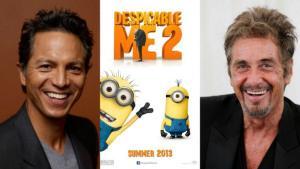
Role: Eduardo, the Mexican restaurant owner Gru (Steve Carrell) suspects is actually a villain in disguise
Original Voice: Al Pacino
Voice We Heard: Benjamin Bratt
The Back Story: It just had its world premiere in Australia two weeks ago, but a mere six weeks ago Despicable Me 2 had no voice for its villain. Even though he had recorded all of his dialogue, Al Pacino quit the film, citing the standard “creative differences” as explanation. Dick move, on Pacino’s part, because they had already tailored all of the animation for the character to his facial tics and mouth movements from his recording sessions. Pacino’s replacement, Benjamin Bratt, attempted to mimic Pacino’s performance entirely until the directors told him to ignore it and do his own thing. This means that when you look at Eduardo in the film you are seeing a character whose face and mouth was modeled to mimic Pacino but whose voice now is that of the half-Peruvian Benjamin Bratt. The cool thing? Unless you really, really know your animation, you’d have no idea there was any disconnect whatsoever. Also, frankly, Pacino’s played Cuban (Scarface) and Puerto Rican (Carlito’s Way), but that was a long time ago. Bratt’s attempt at a Mexican accent is likely far better than anything modern day Pacino could muster (Source: DenofGeek.com).
2) Basically, the Entire Cast of Hoodwinked! (2005)
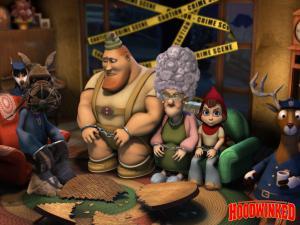
Role(s): Red, Kirk the Woodsman, Det. Bill Stork, Granny Puckett, Chief Grizzly, Woolworth the Sheep
Original Voice(s): Tara Strong, David Ogden Stiers, Tony Leech, Sally Struthers, Joel McCrary, Tom Kenny
Voice We Heard(s): Anne Hathaway, Jim Belushi, Anthony Anderson, Glenn Close, Xzibit, Chazz Palminteri
The Back Story: Hoodwinked!, which retells the Little Red Riding Hood story as a series of alternate viewpoint flashbacks via an after-the-fact police investigation, was independently produced with animation done on the cheap in the Philippines and a cast filled by veteran voice actors instead of big name celebrities. After premiering at the Cannes Film Festival, it gained a distributor in the then-newly formed Weinstein Company, which insisted upon recasting almost every single major character with known names to enhance marketability. As with Despicable Me 2, the film’s animation was in a near-final stage at the time of recasting meaning the new actors had to deliver their lines exactly as the old actors had done with no room for improvisation.
It could have been worse, though. The Weinsteins tried but failed to also recast the roles of Japeth (as voiced by Benjy Gaither) and Jimmy Lizard (as voiced by Joshua J. Greene). Plus, Tara Strong, David Ogden Stiers, Tom Kenny, and Tony Leech had their major roles recast, but they were so versatile they had also voiced side-characters not crucial enough to the plot to warrant re-casting. Sally Struthers and Joel McCrary, on the other hand, had to watch a final film featuring Glenn Close and Xzibit doing vocal impressions of them (Source: Hoodwinked! DVD Commentary).
3) Marin in Finding Nemo (2003)

Role: Marin, the neurotic, over-protective father looking for his lost son
Original Voice: William H. Macy
Voice We Heard: Albert Brooks
The Back Story: Albert Brooks was director Andrew Stanton’s first choice for the crucial role of Marin in Finding Nemo, but William H. Macy was the first actor to actually accept the offer. He recorded all of his dialogue for the film at a point when the film’s script had a far different structure and a rather regrettable surprise reveal about one of the lead characters. It was at this stage of development that Disney CEO Michael Eisner viewed the film, and infamously post-poned re-negotiations on Disney’s co-production deal with Pixar because he was positive Finding Nemo would flop at which point Disney could force Pixar into a bad deal. Yeaaaaaaaah, Finding Nemo became the highest grossing animated film of all time (until Shrek 2 at least). Oops. Eisner was subsequently forced out of Disney.
However, in Eisner’s defense Stanton has admitted the film simply was not working for quite a while. Re-working the script was big, but he credits replacing Macy with Albert Brooks as being the film’s true savior, saying of Brooks, “He is exactly what I needed this father character to be. You needed someone who was neurotic, over-protective but still appealing throughout. And that is one of Albert’s gifts. That he can sort of play both. Usually it’s such an off-putting thing. But he just makes it so winning.”
You hear that, William H. Macy? You’re no Albert Brooks. Go cry about it on Felicity Huffman’s shoulder in your big mansion you worthless bum (Source: Jimhillmedia.com).
4) Shrek in Shrek (2001)
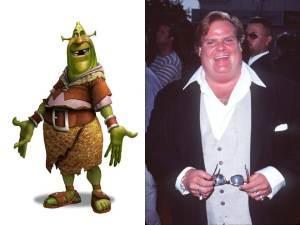
An early design of Shrek at a time when Chris Farley was attached as the voice of the character.
Role: Shrek, the ogre
Original Voice: Chris Farley
Voice We Heard: Mike Myers
The Back Story: The script wasn’t even really finished yet when Chris Farley was cast to voice Shrek, but the animator and writers began tailoring every aspect of the film to Farley’s larger-than-life performance. Then he died in 1997, at which point he had recorded at least over a third of his dialogue. When Farley’s old Saturday Night Live co-star Mike Myers was hired as his replacement the character was re-designed and re-written.
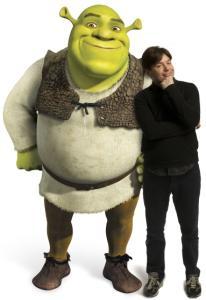
What Shrek became once Mike Myers replaced the deceased Farley as the voice of the character.
But wait – there’s more. After Myers had recorded around half of his dialogue in a non-distinct North American/Canadian voice they screened a rough cut of the film. Myers walked away and came back convinced Shrek should speak with a Scottish brogue, so convinced he offered to pay the requisite $4 million to re-record his dialogue (Dreamworks paid for it, declining his offer). It is here where Shrek as know it really came together. The idea to lampoon fairy-tale characters and take satiric jabs at pop culture properties like The Matrix and Crouching Tiger, Hidden Dragon first entered into the script. Plus, a mixture of modern and old pop songs were added to the musical score, and the always-present irreverent tone of the script saw an infusion of more heart and empathy.
Point of the story? Whenever you hear that Chris Farley was the original Shrek just remember that the version of the film he was cast in only resembles the Shrek we know in its most basic plot. However, according to Myers the film retains one Farley touch in that everytime Shrek speaks using air quotes it is a reference to a key characteristic of Farley’s SNL character Bennet Bowser (Source(s): Allan Neuwirth’s book Makin’ Toons, ResnickInteractive.com).
5) Pacha in The Emperor’s New Groove (2000)
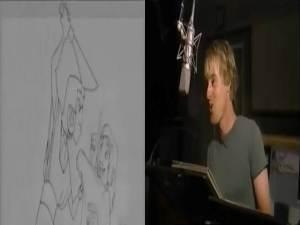
On the left, an early drawing of Empreror Kuzco and Pacha; on the right, Owen Wilson recording his dialogue as Pacha.
Role: Pacha, a sweet-natured llama herder
Original Voice: Owen Wilson
Voice We Heard: John Goodman
The Back Story: A remarkably light but immensely enjoyable film about a selfish 18-year-old Incan emperor humbled after being turned into a llama as part of an attempted coup, The Emperor’s New Groove was originally supposed to be so much more. It went into development the same year The Lion King came out, 1994, and initially featured the same director, Roger Allers. In his Prince & The Pauper-with-a-twist version, Incan emperor Kuzco switches places with a peasant named Pacha who looks like him. The evil witch Yzma uses the opportunity to turn Kuzco into a llama and blackmail Pacha into being her figurative puppet Emperor. The llama Kuzco falls in love with a female llama herder, and the two attempt to take down Yzma somehow. This was to be a more traditional Disney musical titled Kingdom of the Sun featuring original songs from Sting.
David Spade was cast as Kuzco, Owen Wilson as Pacha, and Eartha Kitt as Izma, and most of their dialogue was recorded. However, Disney hired mark Mark Dindal to join as co-director and steer the film more toward comedy, creating a new dim-witted henchman for Yzma named Kronk. Allers didn’t like the new direction and quit in 1998, at which point Disney threatened to cancel the project entirely. Dindal and producer Randy Fullmer shut down production to re-tool, at which point they dropped the Prince & Pauper stuff entirely, Yzma’s evil plan to block the sun, and all of Sting’s songs as it was no longer going to be a musical. They combined Pacha with the original female love interest and turned it into a bromance. Owen Wilson didn’t really match this new version of Pacha so he was replaced with John Goodman.
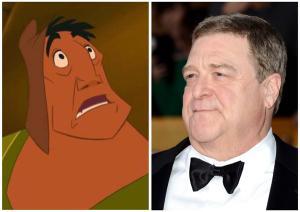
John Goodman as Pacha after the entire film was re-designed.
Much of this drama was caught in The Sweatbox, a documentary made about the making of the film by Sting’s wife (Source: LaughingPlace.com).
6) Mushu in Mulan (1998)
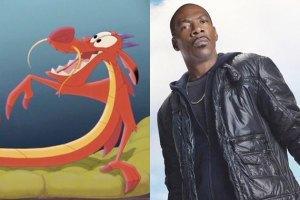
We were going to do a picture of Joe Pesci next to Mushu, but just look at Eddie Murphy in that picture. We’re frankly scared of ever crossing him.
Role: Mushu, the dragon
Original Voice: Joe Pesci
Voice We Heard: Eddie Murphy
The Back Story: Unlike most of the others on this list, Joe Pesci appears to have barely gotten his foot in the door on Mulan by the time the filmmakers changed their mind. Mushu the dragon was to be a comic relief presence, split into separate entities named Yin and Yang who would meld together in the end to form the whole Mushu. They were looking at Joe Pesci and Richard Dreyfus to voice Yin and Yang, but once they got Pesci into the studio they realized his voice was completely wrong for the role. Disney CEO Michael Eisner intervened and called in an old favor to get Eddie Murphy (who owed some of his fame to Eisner’s assistance behind the scenes on Beverly Hills Cop) to play Mushu, at which point the Yin and Yang concept was dropped. Murphy’s presence greatly informed the writing and animating of the character from that point forward, and it’s worth speculating whether or not Dreamworks would have ever thought of Murphy to voice Donkey in Shrek if not for his work in Mulan (Source: CuratorMagazine.com).
7) Hades in Hercules (1997)

Role: Hades, the Lord of the Underworld.
Original Voice: John Lithgow
Voice We Heard: James Woods
The Back Story: On this site, we once described Disney’s Hercules as being “almost unbearably bright and chipper, as if Disney had an autoimmune disorder response to” The Hunchback of Notre Dame (1996), i.e., the incredibly bleak film they had released one year earlier. However, one aspect of the film which is truly and completely brilliant is James Woods’ vocally inventive performance as Hades. He wasn’t the filmmakers’ first choice, though. Heck, he wasn’t even their second choice. They initially asked Jack Nicholson, but had to give up on him when he demanded what he got on Batman-a good salary plus a significant percentage of back-end profits. John Lithgow was cast as Hades in the fall of 1994, a part he retained for 9 months. However, no matter what they tried he just wasn’t funny enough in the role. Wait, what? Lithgow was hilarious – undeniably hammy, but hilariously so – as Dick Solomon on 3rd Rock from the Sun. What gives? Well, that’s actually the role he went into directly after having been released from his contract with Hercules. I guess he proved them wrong.
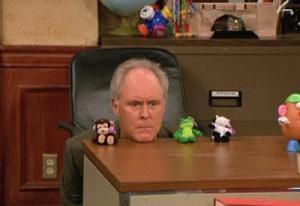
This is the guy they thought wasn’t funny enough and generally too hammy? Well, they really weren’t wrong about that last part, but it totally works for him.
So, with 20 months to the film’s scheduled release they were without a voice for their villain. The Disney casting department insisted the filmmakers try James Woods in the role, who was only an obvious choice for the part if you had seen his guest turn as himself in a classic episode of The Simpsons. Things didn’t go all that smoothly at first until the filmmakers directed Woods to just do an impression of the smooth talking, schmoozy producer Jeffrey Katzenberg. The character was even animated to slightly resemble Katzenberg. Why? At that time, this was pre-Dreamworks meaning Katzenberg was still a high level producer at Disney. He actually forced the filmmakers to do Hercules in exchange for getting to later make their dream film, Treasure Planet. So, to them Katzenberg was basically the devil (Source: AnimationArchive.net).
8) The Hyenas in The Lion King (1994)
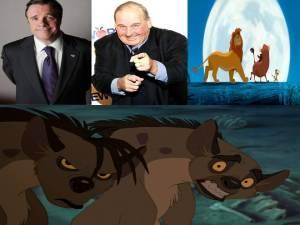
Nathan Lane & Ernie Sabella delivered beloved performance as Timon and Pumbaa, but were briefly cast as the hyenas instead.
Role(s): The evil hyenas Banzai and Shenzi
Original Voice(s): Nathan Lane & Ernie Sabella
Voice(s) We Heard: Whoopi Goldberg & Cheech Marin
The Back Story: During the auditioning stage for The Lion King, Nathan Lane auditioned for Zazu (the role which went to Rowan Atkinson) and Ernie Sabella for one of the evil hyenas. Lane and Sabella were co-starring together at the time in Guys & Dolls on Broadway and were good friends. When they ran into each other at auditions, the casting people asked them to record dialogue together as the hyenas. Some report this as them having been officially cast in those roles or simply a one-off “let’s have a laugh and see how it goes.” Of course, the resulting recording session so amused everyone it was decided the two were wrong for the hyenas but perfect for the parts of Timon and Pumbaa. For the hyenas, they tried to reunite Cheech & Chong (because little kids love to see stoner film icons reunited), but only Cheech Marin was available. So, he was paired with Whoopi Goldberg, whose hyena was re-written to be female (Source: The Los Angeles Times).
9) Ursula in The Little Mermaid (1989)
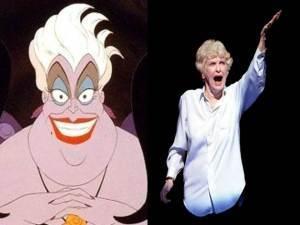
Elaine Stritch will forever be the originator of the Broadway standard “The Ladies Who Lunch,” but she was dang close to also being the originator of “Poor Unfortunate Souls”
Role: Ursula, the villainous octopus witch
Original Voice: Elaine Stritch
Voice We Heard: Pat Carroll
The Back Story: We poor unfortunate souls were almost robbed of hearing Pat Carroll’s iconic singing of, well, “Poor Unfortunate Souls” as Ursula in A Little Mermaid. Co-directors Ron Clements and John Musker envisioned Bea Arthur, then on The Golden Girls, in the role of Ursula, and even described her as having a Bea Arthur-type basso voice in the script. However, Arthur actually turned them down, although Musker has argued he doesn’t think her agent even gave her the script (because she thought Arthur was too good to even be thought of as a witch). Company star Elaine Stritch was eventually cast, recording her dialogue in a deep, raspy voice and playing a kind of boozy witch. However, her struggles with alcoholism and dislike for music director Howard Ashman’s style led to her being fired. Theater actress Pat Carroll got the part, and her campy and deliciously evil performance made for one of the all-time great Disney villains (Source: Allan Neuwirth’s book Makin’ Toons).
My words have now reached their conclusion. It is your turn. Any example I somehow missed in this list? if so, darn! Please let me know. Do you struggle to imagine any of the above original castings sounding as good as the voices we ended up hearing in the role, and if you fell that way isn’t it likely that now that we’ve heard the part done one way it’s hard to imagine it having ever been done any other way? Let me know what you think in the comments.

